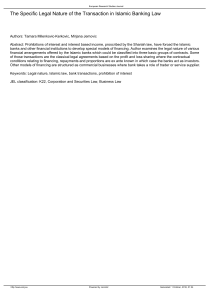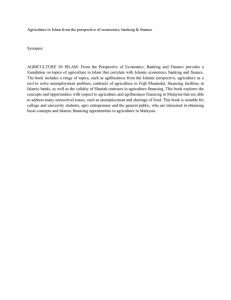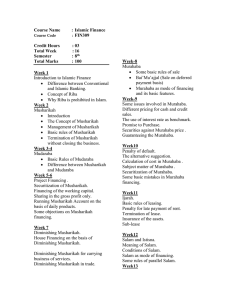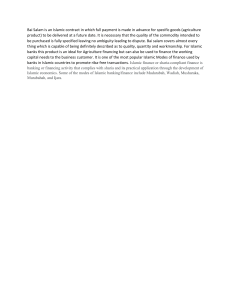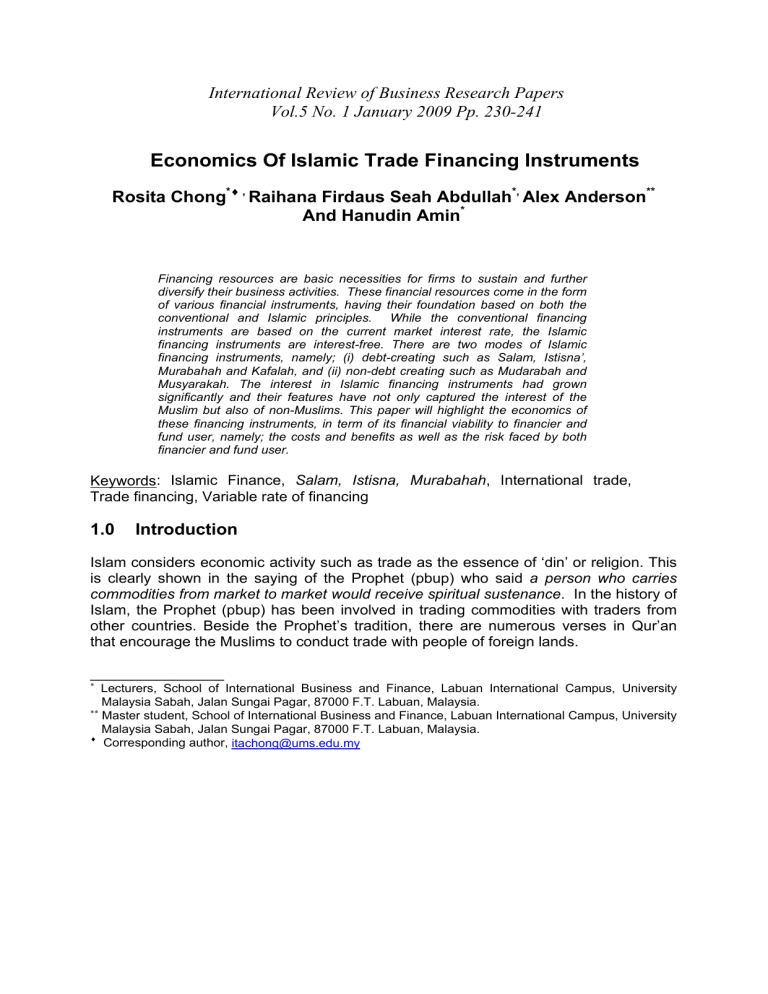
International Review of Business Research Papers Vol.5 No. 1 January 2009 Pp. 230-241 Economics Of Islamic Trade Financing Instruments Rosita Chong*♦ , Raihana Firdaus Seah Abdullah*, Alex Anderson** And Hanudin Amin* Financing resources are basic necessities for firms to sustain and further diversify their business activities. These financial resources come in the form of various financial instruments, having their foundation based on both the conventional and Islamic principles. While the conventional financing instruments are based on the current market interest rate, the Islamic financing instruments are interest-free. There are two modes of Islamic financing instruments, namely; (i) debt-creating such as Salam, Istisna’, Murabahah and Kafalah, and (ii) non-debt creating such as Mudarabah and Musyarakah. The interest in Islamic financing instruments had grown significantly and their features have not only captured the interest of the Muslim but also of non-Muslims. This paper will highlight the economics of these financing instruments, in term of its financial viability to financier and fund user, namely; the costs and benefits as well as the risk faced by both financier and fund user. Keywords: Islamic Finance, Salam, Istisna, Murabahah, International trade, Trade financing, Variable rate of financing 1.0 Introduction Islam considers economic activity such as trade as the essence of ‘din’ or religion. This is clearly shown in the saying of the Prophet (pbup) who said a person who carries commodities from market to market would receive spiritual sustenance. In the history of Islam, the Prophet (pbup) has been involved in trading commodities with traders from other countries. Beside the Prophet’s tradition, there are numerous verses in Qur’an that encourage the Muslims to conduct trade with people of foreign lands. ________________ ∗ Lecturers, School of International Business and Finance, Labuan International Campus, University Malaysia Sabah, Jalan Sungai Pagar, 87000 F.T. Labuan, Malaysia. ∗∗ Master student, School of International Business and Finance, Labuan International Campus, University Malaysia Sabah, Jalan Sungai Pagar, 87000 F.T. Labuan, Malaysia. ♦ Corresponding author, itachong@ums.edu.my Chong, Abdullah , Anderson & Amin Financing resources are necessary for firms to sustain and diversify their business activities. There are various financial instruments available to fulfil these financing needs. They are conventional instruments which are based on the current market interest rate while the Islamic instruments are interest-free. The literature on Islamic financing to date has concentrated on the general discussion of Islamic financing. Not much work has been done in the areas of financing instruments. Thus this research aims to fill the void found in the current literature. Many firms even large corporation owned fully Muslim entrepreneurs still preferred to adopt the conventional trade financing instruments to conduct their businesses (Chong, 2006). In order for Islamic financing instruments to be accepted by global players especially non-Muslims, research must be undertaken to demonstrate that the Islamic mode of financing is, in fact, economically viable. There are studies on the instruments in term of nature, control of the fund and risk borne by the fund provider, (Kahf, 1994; Haron and Shanmugan, 2001), however, we are not aware at this juncture of any study that examined viability of the Islamic financing instruments. This research will help to shed some light on the efficiency of the instruments from both the provider of fund (financier), and the user of fund (firm) perspectives. It is hoped that this research will be able to contribute to the current literature on Islamic Finance (IF). The paper is structured as follows; section 2 reviews the literatures on Islamic and international trade financing. Section 3 examines the features of the technique of financing trade, namely; Salam, Istisna, Murabahah and Kafalah. Section 4 examines the viability of the financing instruments. Finally, section 6 concludes the paper. 2.0 Literature Review There is a vast literature on Islamic Finance (IF) especially on the operation of the Islamic Banking (IB). However, no study on the economic viability of Islamic trade financing instruments has been reported. The mode of financing during the Prophet’s (pbup) time did not only arise due to the differences in term of resource endowment but also as a source of income. The Mudarabah mode of financing, which had been practised by Prophet (pbup) and Khadijah started fifteen years before the beginning of the revelation. Udovitch (1967) provided evidences of the hadith that allowed traders to do their business transaction on credit. Nevertheless, nowadays, according to Aggarwal and Youssef (1996), Hassan and Ahmad (2002), Dar and Presley (1999) and Rosly (2005), the available trade credit instruments are basically debts instruments. Hence, businessmen who require financing facilities from the bank are faced with the dilemma whether there is any difference between the Islamic and the conventional instruments. 231 Chong, Abdullah , Anderson & Amin They are indifferent to the use of the Islamic instruments to finance their trading activities as they believed they are the similar. This is evident in an exploratory study undertaken by Norafifah and Haron (2002) that showed that on the average the Islamic trade financing used were only 7.5% as compared to 62.7% of the conventional instruments. A study on the ability of the principle of IF to respond to the needs of international trade was undertaken by Kahf (1999) showed that the Islamic financing modes were found able to assist exporters, importers and producers. 3.0 Features Of Islamic Financing Instruments The two modes of financing that have been used to finance business both domestic and international are debt-creating and non-debt creating modes (Khan, 1999; Haron and Shanmugam, 2001). The paper tries to bring forth debt-creating modes namely; Salam, Istisna’, Murabahah and Kafalah in conducting international trade. While Salam and Murabahah have been prevalent during the time of the Prophet, Istisna’ is not. It is created by consensus of opinion of the ulama’. The illustration for Salam, Istisna’ and Murabahah modes of financing have been adapted and refined from Chong et.al. (2007). 3.1 Salam Salam is a contract of sale and purchase between supplier of good (exporter) and the firm who is the purchaser (importer). The purchaser has to make the payment in advance but delivery of the good is deferred to an agreed date in the future. According to Kahf and Khan (1989), the price of the goods in a Salam financing is paid at the time of contract but goods becomes due as debt in kind. Assume that Sabah Palm Oil Growers (SPOG), the exporter has received an order to produce palm oil for an Australian Oil Refinery (AOR) who is prepared to pay wholesale market price but with an LC. The current market price of palm oil is MYR6/ ton, which is set on the spot and is known as the Salam price. The wholesale price is MYR3.00/ton. The palm oil needs one year to be ready. SPOG is estimated to produce about 100,000 tons of palm oil. 232 Chong, Abdullah , Anderson & Amin Figure 1: Salam Financing (8) 08/01/01 MBB purchases 100,000 tons palm oil at RM2.50/tons from SPOG (2) 02/01/01 SPOG presents proposal to MBB for finance and accepted (9) 09/01/01 MBB pays MYR250,000 (10) 09/01/02 SPOG delivers 100,000 tons of Palm Oil to MBB SABAH PALM OIL GROWERS (SPOG) (7) 08/01/01 MBB except order to sell palm oil at RM3.00/tons to AOR MAYBANK Berhad (MBB) (11) 09/01/02 MBB delivers 100,000 tons palm oil to AOR (3) 04/01/01 SPOG and AOR communicate and AOR faxes the order to SPOG for 100,000 tons of Palm oil, Cash on Delivery (1) 01/01/01 AOR communicate with SPOG for an order of 100,000 tons of Palm Oil for the price of MYR3.00/tons (5) 05/01/01 MBB communicate with NBA to confirm the order from AOR and request letter of credit (6) 07/01/01 NBA gives Letter of credit to MBB to secure the order (13) 10/01/02 AOR pays MYR300,000 through NBA NATIONAL BANK OF AUSTRALIA (NBA) (4) 06/01/01 AOR communicate with NBA and buys letter of credit (12) 10/01/02 AOR instruct NBA to release money AUSTRALIAN OIL REFINERY (AOR) Assume SPOG needs RM100,000 cash, and currently MAYBANK Berhad (MBB) (the financing bank) is offering a Salam financing scheme. It is permissible for MBB to earn profit from this financial transaction and also permissible for SPOG to sell the palm oil, even though it is not available at the time of the transaction (Nawawi,1999). MBB buys the palm oil from SPOG but pay in advance. It sells the palm oil to AOR and delivers the goods in one year’s time. For MBB to buy the palm oil on Salam basis, the price will have to be lower than the market price. Suppose on 1st January 2001, both parties set the price at MYR2.50/ton. MBB pays SPOG MYR250,000 today in exchange for the 100,000 tons of palm oil to be delivered in one year. SPOG earns MYR150,000 from this transaction. The cost of production is MYR100,000 while sales is MYR250,000. Although the price it gets is the current wholesale price of MYR3.00/ton, it is acceptable for MBB since the sale is considered settled as it has already received the LC to cover the long term sale risk such as the client might change his mind or the price goes down. 3.2 Istisna According to Rosly (2005) and Muhammad al-Amine (2001), Istisna’ can be used to finance manufacturing of products. It is a sale contract whereby a manufacturer undertakes to supply goods to a buyer at a future date in exchange for an advance price fully or partially paid on the spot. 233 Chong, Abdullah , Anderson & Amin Figure 2 illustrates Istisna’ financing. Assume that Harvey Norman Corporation (HNC) in Australia expresses its desire to purchase 100,000 units of DVD recorders worth MYR13 million from Panasonic (M) Corporation (PMC). It is willing to pay MYR130/unit when the recorders are delivered. The cost of production is MYR95/ unit. Figure 2: Istisna’ Financing (7) 06/01/06 MBB purchases 100,000 units at MYR120/unit and pay in 6 instalments. (3) 02/01/06 PMC presents proposal to MBB for a finance (8) 07/01/06 MBB starts financing PMC and pays MYR 1 million (1) 01/01/06 HNC negotiated with PMC for an order of 100,000 units DVD recorders at MYR120/unit MAYBANK (M) BANK (MMB) (8b) (8c) 07/02/06 MBB pays 07/03/06 (8d) MBB pays 07/04/06 MYR 1 MYR 1 million MBB pays million MYR1 million (8e) 07/05/06 MBB pays MYR1 million (9) 08/06/06 MBB pays remaining MYR 7 Million after shipment conformation PANASONIC (M) CORPORATION (PMC) (2) 02/01/06 HNC faxes the order of 100,000 units DVD recorders at MYR130/unit to PMC Cash on Delivery if delivered before 01/07/06 (10) 06/06/06 100.000 DVD recorders delivered to HNC (4) 03/01/06 MBB & CBA communicate With each other and MBB request letter of credit (6) 05/01/06 CBA Bank faxes Letter of Credit to MBB (12) 08/06/06 CBA release MYR13 million to MBB COMMONWEALTH BANK OF AUSTRALIA (CBA) (5) 04/01/06 CBA communicate With HNC for order conformation and acquisition of letter of credit (11) 07/06/06 HNC informs CBA goods arrived HARVEY NORMAN CORPORATION (HNC) PMC lacks fund to start production but it has the capacity to produce the goods on the agreed date 06/06/06. Therefore, PMC presents a proposal for financing to MBB with the confirmed order. MBB agrees to finance its production under Istisna’ by buying 100,000 units recorders for MYR120/piece. The order is worth MYR12 million. MBB agreed to finance PMC’s production in six partial payments starting immediately from 06/01/06 until the recorders are delivered in six months time on the 06/06/06. In six months time, MBB receives the goods, then sells them to HNC for MYR130/unit and makes a profit of MYR1 million. MBB then communicates with CBA to negotiate for an LC worth MYR13 million. Assume, CBA agrees to issue a LC for a fee of AUD5000 and faxes the LC worth MYR13 million to MBB, which then releases the first part of the funding amounting MYR1 million on 07/01/06 and the remaining amount over the next five months until completion of the goods. When the order is completed on 06/06/06, the goods will be delivered by PMC on behalf of MBB. When HNC received the order, it advises CBA to release the payment of MYR13 million to MBB of which MBB made a profit of MYR1.5 million while PMC made MYR25 (MYR120 – MYR95) per unit, totalling MYR2.5 million. 234 Chong, Abdullah , Anderson & Amin 3.3. Murabahah Murabahah is the most widely used principle (Haron and Shanmugam, 2002). It is a contract of sale and purchase at a profit margin between the supplier and the purchaser of the good. The cost and profit from the transaction must be known in advance and agreed by both parties to the contract. Under this principle, the financier, would purchase goods and later resell them to the customers on a mark-up price, agreeable to both parties. Figure 3 illustrates the mechanic of Murabahah financing. Figure 3: Murabahah Financing (3) 03/02/07 MMB agreed to provides Murabahah financing to LKC and order the yarn from AWC (2) 02/02/07 LKC negotiates with MBB for a Murabahah financing amounting to MYR500,000 (5) 05/03/07 MBB sells the Woollen Yarn to LKC for a MYR625,000 on a deferred payment basis (9) LKC settles MBB selling price of MYR625,000 on an agreed due date LABUAN KNITWEAR COMPANY (LKC) MAYBANK BERHAD (MBB) (4) 04/02/07 LKC orders the 5000kgmWoollen Yarn for MYR500,000 from AWC to be delivered to LKC (1) 01/02/07 LKC & AWC negotiate the supply of 5000kgm of Woollen Yarn for MYR500,000 from AWC paid in cash term (8) 07/02/07 AWC supplies the yarn to LKC (6) 05/02/07 MBB settles the purchase price on cash basis to AWC through CBA COMMONWEALTH OF AUSTRALIA (CBA) (7) 06/02/07 CBA confirm payment from AWC AUSTRALIA WOOL COMPANY (AWC) Assume that Labuan Knitwear Company (LKC) needs 5000kg of woollen yarn to make jumpers. It communicates with a supplier in Australia called Australian Woollen Yarn Company (AWC). LKC purchases an order of MYR500,000 worth of woollen yarn from AWC who supplies to LKC based on cash on delivery (COD). LKC does not have sufficient funds, hence negotiates with MBB for a Murabahah financing amounting to MYR500,000. MBB agrees to provide the financing to LKC. MBB buys the yarn from AWC and settles the purchase price on cash basis. MBB then sells the yarn to LKC at a mark-up of MYR125,000. LKC then make the settlement with MBB on a deferred payment based on the agreed date. LKC settles the payment with MBB based on the mark-up price allowing MBB to earn some profit. 3.4 Kafalah Variable rate of financing (VRF) was first introduced in Malaysia in 2003 and has been widely applied to house, property, trade financing and other type of financing. The introduction of VRF by the Malaysian’s Islamic Banking industry (Central Bank of Malaysia) is to ensure that the fund user enjoys a competitive rate of repayment in time of economic volatility, where the market interest rate (BLR) fluctuates. From the illustrations in Figures 1 and 2, the purchaser (importer) provides a LC under Kafalah financing based on the VRF contract with MBB, the financier. MBB purchase 235 Chong, Abdullah , Anderson & Amin yarn on behalf LKC from AWC and sell it to LKC with deferred payment. Before the MBB executes the purchase, LKC and MBB must agree on ceiling rate of profit such as 5% per annum in the preceding illustrations. Commission = (Value of LC * c * t)/100 where c: monthly commission rate changed t: period of the LC (in months) No Economic volatility If market interest rate = 5% per annum (Ceiling rate of profit) Value of LC = MYR1,000,000 Period of LC = 4 months Conventional Bank (MYR1,000,000 * 5/12 * 4)/100 = MYR16,666.67 IB (MYR1,000,000 * 5/12 * 4)/100 = MYR16,666.67 The firm has to pay MYR16,666.67 as commission to both conventional and Islamic Banks for using the facility. Case 1: Interest Increase to 8% per annum Conventional Bank (MYR1,000,000 * 8/12 * 4)/100 = MYR26,666.67 IB (MYR1,000,000 * 5/12 * 4)/100 = MYR16,666.67 If the interest rate increases to 8% per annum, firm using conventional financing instrument has to pay MYR26,666.67, while firm using Islamic financing instrument has to pay the maximum charge agreed by both party in advance. It shows that when interest rate hikes to a higher rate (more than 5%), the fund user of IB can enjoy the benefit under VRF contract. But client of conventional bank will be required to pay based on prevailing market rate. Case 2: Interest Decrease to 3% per annum Conventional Bank (MYR1,000,000 * 3/12 * 4)/100 = MYR10,000.00 IB (MBB, the financier) (MYR1,000,000 * 3/12 * 4)/100 = MYR10,000.00 If the BLR decrease to 3% per annum, the Islamic fund user has to pay only MYR10,000 to IB. It shows that Islamic fund user is gaining. However, issue such as the permissibility of this type of financing may arise. But in case 1, no such issue arise as the fund user has only to pay the cost stated in the contract. In case 2, a rebate or ibra’ will be granted to the fund user. The bank will give MYR6,666.67 as a rebate, which is the different between ceiling rate of profit 5%. The total amount of rebate given by bank is based on the BLR. Shaharuddin and Mohd. Safian (2005) stated that it is 236 Chong, Abdullah , Anderson & Amin permissible for IB to practice ibra’ as cited in the Holy Qur’an Surah Al-Baqarah, 2:280: “If the debtor is in a difficulty, grant him time till it is easy for him to repay. But if ye remit it by way of charity, that is the best for ye if ye only knew” (Yusuf Ali, 2001). Another evidence indicates that ibra’ is enjoin by Islam is a Hadith narrated by Imam Al-Bukhari in case of Ka’ab and Ibn Abi Hadrad, Ka’ab were asking Abi Hadrad to repay his debt in a mosque and Prophet (pbuh) had instructed Ka’ab bin Malik to practice ibra’ and give discount on debt. The above verse and Hadith indicated that the practice of ibra’ is lawful from the Shari’ah perspective. 4.0 Analysis Of Efficiency Of The Islamic Financing Instruments 4.1 Financiers’ Perspectives Deposit from the surplus unit is a source of fund for the bank (financier), where banks are able to mobilize funds from the public to stimulate the economic activity. Through financing, the bank is able to generate income. The profits earned by an IB are used to pay their operation cost and the balance is distributed as a reward to the depositors. Sources of fund for a bank form the source of funds to finance the deficit units’ needs. This indicates that bank is borrowing (PLS) short term from the surplus unit and financing long to the deficit unit. The risk borne by the bank is greater; nevertheless, the reward expected will be greater too. The disadvantage that the bank faces is that the average maturity of deposits is shorter than average maturity of Murabahah contract (Syed Ali, 2004). The types of risk that are faced by the bank are liquidity risk and credit risk. Liquidity risk arises due to the nature of the Murabahah contract which prevents the bank from transferring Murabahah receivables to third party. If the firm fails to pay on time, credit risk occurs and this contributes to the increase in liquidity risk for the bank as the financier. Another risk borne by the financier in Murabahah financing is in the form of Murabahah receivables which are debt based. It cannot be sold at a different price, either at higher or lower price since debt must be sold at par (Rosly, 2005). Similar as in the case of Salam contract, risk borne by the financier arises if the seller is unable to deliver the goods to the bank. When the bank needs cash, bank is not permitted to transfer the contract to third party because it is cited in the Qur’an, “Oh you who believed, do not sell what you do not own”. There are some indirect risks arises in Salam contract namely; (i) If the manufacturer is unable to deliver the goods to the buyer (financier) due to the natural disaster, credit risk arises for the bank, and hence increases the bank liquidity risk. (ii) If the seller is able to deliver the goods, issues such as quality, quantity and other attribute will be the risk associated with Salam contract (Syed Ali, 2004). In the Istisna’ contract, the risk borne by the financier according to Syed Ali (2004) is the liquidity risk similar to a Salam contract. This is because both contracts are debt based and debt cannot be trade in any price except at par. The liquidity risk arises in Istisna’ 237 Chong, Abdullah , Anderson & Amin contract is lower than Salam contract. The feature of Istisna’ contract allowed bank to release payments based on the progress of manufactured goods and this is permissible by the Shari’a. The bank is allowed to release payment to the manufacturer on instalment basis as compared to Salam contract where payment is made in advance (Syed Ali, 2004). Other than liquidity risk, bank is also exposed to credit risk if the manufacturer fails to deliver goods. Therefore, it can be concluded that the risks the financier faces do not only come from seller, but also from the market condition. The financier risks the fund he provides as the commodity that is delivered in the future may not be up to expectation. There is also the opportunity cost of the fund to him. In a Salam contract, the fund user is obliged to pay back the entire value of the commodity as agreed earlier. This is because repayment by the fund user is predetermined in advance. Since Salam is the mode of financing for agricultural product, the risk borne by financier is related to uncertainty concerning the future price of the commodities in the contract. This is because it might be lower than the future prices at the time the commodity is delivered. These risks keep the rate of return uncertain until the goods have been finally handed over to the fund user. However, in the case of Murabahah, the mark-up creates a fixed, pre-determined and secure indebtedness. This thus, has made the Murabahah financing attractive for the IBs as an alternative to the interest based transactions. 4.2 Firm’s Perspectives Efficiency of the instruments will be achieved if with the given level of resources, a firm is able to maximise its profit. In term of the cost of fund for firm, in Murabahah financing, the mark-up price saves the user of funds the risks which he would have otherwise borne had he owned the goods for the same period of time. Thus the final cost for the finance user may be less than the mark-up price (Khan 1989). The cost of fund for the firm according to Khan (1994) is the amount that the firm has to pay to the financier which is above the original amount of funding received. The risk borne by firm in the Salam sale is the price risk. Manufacturer may face a loss if upon delivery the market price has gone up. He cannot demand the financier to adjust the Salam price upwards, since this invalidates the Salam contract. While in a Murabahah financing, the financier faces all risks in a normal trading such as goods getting damaged during transportation or storage. The bank also runs the risk that the goods purchased may not be acceptable by the user due to quality. In term of rate of return for fund user, in a debt-creating mode of financing, the repayment by the manufacturer is also predetermined in advance, which is considered a debt from his perspectives. The bank has full control over the use of the funds since funds are deployed by the fund provider. Hence, the risk borne is only up to the stage when the goods are handed over to the fund user. Once the goods are handed over all risk lies with him and he shares no risk till the recovery of the fund. The mark-up based financing involves minimum risk for the bank because the bank does not bear risk for the entire period of the contract. 238 Chong, Abdullah , Anderson & Amin 5.0 Conclusion Islamic trade finance has played an important role in facilitating international trade since the times of the Prophet. With the rapid process of globalisation, its role is even vital in bridging the trade between countries. The principle of Kafalah, Salam, Istisna’ and Murabahah financing have great potential in fostering cooperation in business activities around the globe. There is no doubt that problems persist in promoting the usage of these instrument due to the asymmetric information problem. However, there is much more to gain than loss. The reluctant of the Western firms to adopt Islamic trade financing instruments was mainly due to their ignorant of IF. With the keen interest of the Westerners on IF coupled with the opening up of more IBs in Western countries, it has shown that the Westerners are beginning to accept the Islamic mode of financing. This paper has shown that in reality the Islamic modes of financing such as Salam, Istisna’, Murabahah and Kafalah LC can complement the traditional financing. This is the traditional instruments such as letter of credit and bank guarantee practised by the conventional bank that are based on fee are permissible in Islam. This fact has been overlooked by Muslim when dealing with Western firms. It is thus necessary that Western firms understand the principle of Islamic trade financing in order to understand the preferences of Muslim businessmen in facilitating trade between them. At the same time, the acceptances of the Islamic financing instruments among the Muslim provide a form of unification of the Islamic trade finance since everyone agrees and accepts the underlying principles of the financing instruments used. References Aggarwal, R. & Yousef, T. 2000. “Islamic Bankings and investment financing”, Journal of Banking and Finance, vol. 32, no. 1, pp. 93-120. Berger, A.N, DeYoung, R, Geney, H and Udell, G.F. 1999. “Globalisation of financial institutions: Evidence from cross-border banking performance”. Working paper series WP 99-25, Federal Reserve Bank Chicago. Central bank of Malaysian (www.bnm.gov.my) Chong, R.K. 2006, “Economics of funding instruments: An empirical analysis of conventional and Islamic instruments”, Unpublished thesis. Chong, R.K, Mohammad, M.Z, Abdullah, R.F and Anderson, A. 2007, “Prospect of Islamic financing in bridging international trade”, Proceeding for the ICABE 2007, 239 Chong, Abdullah , Anderson & Amin International Conference on Applied Business & Economics, 4-6 October 2007, Piraeus, Greece. Dar, H.A. and Presley, J.R. 2000, Lack of profit and loss sharing in Islamic Banking: Management and control imbalances. Centre for International, Financial and Economic research. University of Loughborough, UK. Dar, H.A. and Presley, J.R. 1999, “IF: A western perspective”, International Journal of Islamic Financial Services. vol. 1. Hassan, M.K, & Ahmed, M. 2002, Islamic Baking versus conventional banking: A questionnaire survey of their apparent similarities and differences. The First International Conference on Islamic Baking, Finance and Insurance Reshaping Global Financial Architecture through the Islamic System, 30-31st January 2002, Malaysia. Honovan, P. 2001, Islamic financial intermediaries: Economic and prudential considerations. Development Research Group and Financial Sector Strategy and Policy Department. The World Bank. Kahf, M. & Khan, T. 1989, Principles of Islamic financing: A survey. Islamic Research and Training Institute, Islamic Development Bank. Kahf, M. 1999, “Financing international trade: An Islamic alternative”, Seminar on International Trade from Islamic Perspective, April 1999. IKIM, Malaysia. Khan, M.F. 1994, “Comparative economics of some Islamic financing techniques”, Islamic Economic Studies, vol.2. no.1, pp. 35-68. Lewis, M.K 2002, “Islamic Banking from western perspectives”. The First International Conference on Islamic Banking, Finance and Insurance Reshaping Global Financial Architecture through the Islamic System, 30-31st January 2002, Malaysia. Muhammad Al-Amine, M.A.B. 2001, Istisna’ in Islamic Banking and Finance: Law & Practice Kuala Lumpur: ASN Publishing. Nawawi, R. 1999, Islamic law on commercial transaction. Malaysia: CT Publications. Norafifah, N. and Haron, S. 2002, “The potentiality of Islamic products and services in fulfilling corporate customers’ banking requirements” The First International Conference on Islamic Banking, Finance and Insurance Reshaping Global Financial Architecture through the Islamic System, 30-31st January 2002, Malaysia. Rosly, S.A. 2005, Critical issues on Islamic Banking and financial markets, Malaysia: Dinamas Publishing. 240 Chong, Abdullah , Anderson & Amin Samad, A. and Hassan, M.K. 1999, “The performance of Malaysian Islamic Bank during 1984-1997: An exploratory study”. International Journal of Islamic Financial Services. vol.1, no.3. Shaharuddin, A. and Mohd.Safian, Y.H. 2005. “Variable rate financing in Malaysian Islamic Bankings: A jurisprudential analysis” Proceedings of the International Conference in Economics and Finance (ICEF), pp.175-181. Sudin, H. and Shanmugam, B. 2001, Islamic Banking system: Concepts & applications. Malaysia, Pelanduk Publications. Syed Ali, S. 2004, “Islamic modes of finance and associated liquidity risks”. Conference on Monetary Sector in Iran: Structure, Performance and Challenging Issues. Tehran Udovitch, A.L. 1967, “Credit as a means of investment in medieval Islamic trade”. Journal of the American Oriental Society, vol. 87, no.3, pp. 260-264. Yusuf Ali, A. 2000, The holy qur’an (translation). Saba Islamic Media. Sdn. Bhd. 241

